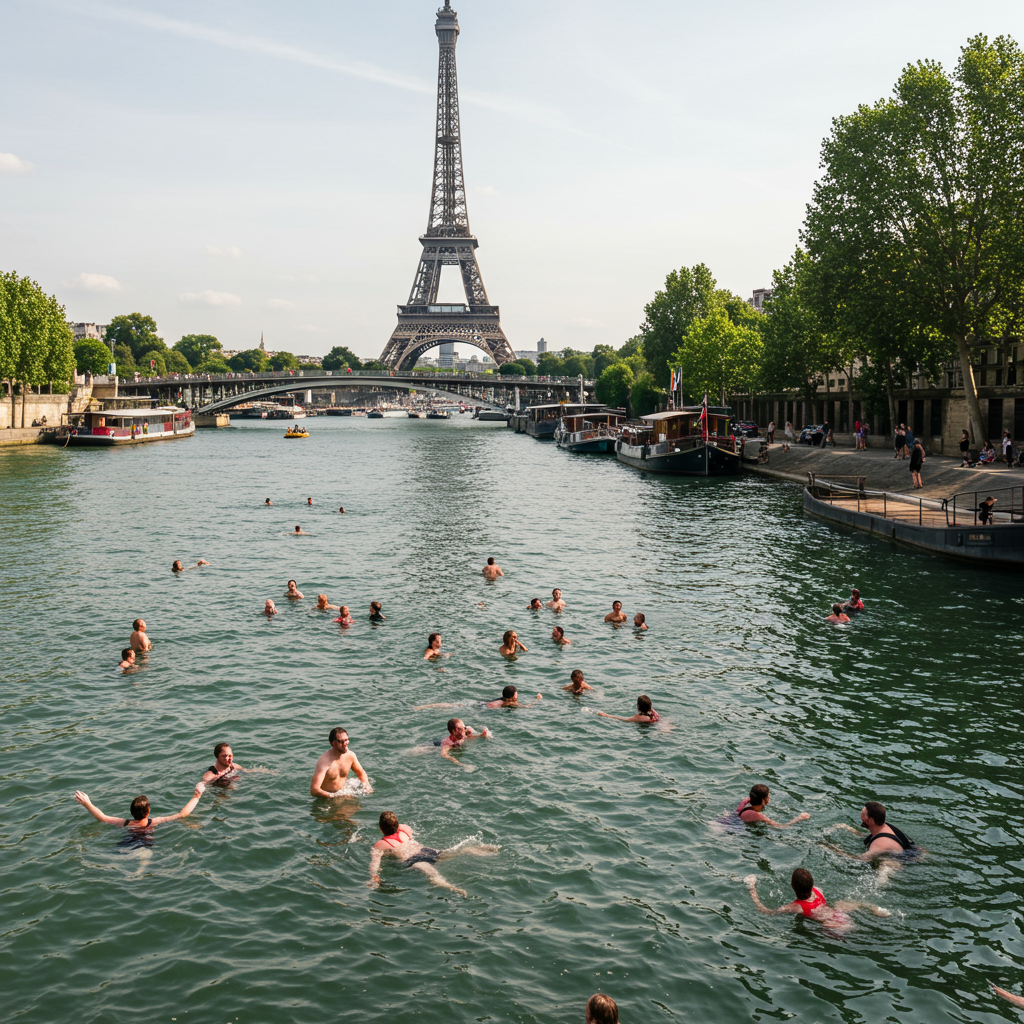After a century-long hiatus, public swimming has officially returned to the iconic River seine in Paris. This historic moment, celebrated on July 5, 2025, marks the first time since 1923 that residents and visitors alike can legally dip into the city’s central waterway. The reopening is a significant milestone, viewed as a lasting legacy of the Paris 2024 Olympic Games and the result of decades of dedicated environmental efforts.
For generations, the Seine was off-limits to swimmers due to severe pollution. High levels of faecal bacteria and other contaminants made the water unsafe, posing serious health risks. The ban, instituted in 1923, became a stark reminder of the impact of urban development and industrialization on natural waterways. Reversing this required a monumental cleanup operation.
A Monumental Cleanup Effort
The path to clean water was long and complex. The promise to lift the swimming ban dates back decades to 1988. Then-mayor of Paris and future President Jacques Chirac first championed the idea of reclaiming the Seine for public bathing. However, turning this vision into reality demanded substantial investment and technological advancements.
In the 20 years leading up to the recent reopening, significant improvements were made to reduce pollution entering the river. This included upgrading wastewater treatment facilities and connecting previously unconnected buildings to the sewage system. The most intensive phase of cleanup was directly tied to the city hosting the 2024 Olympics.
Billions Invested for a Swimmable Seine
Over €1.4 billion (approximately $1.6 billion) was invested specifically to prepare the Seine for Olympic open water swimming and triathlon events. This massive funding targeted infrastructure improvements, particularly upstream, to prevent sewage overflows. For instance, connecting roughly 2,000 buildings that were bypassing the sewage network directly into the river was a key step.
The goal was clear: make the Seine safe enough for elite athletes to compete. This ambitious target pushed authorities to implement advanced monitoring systems and stricter water quality standards. Paris Mayor Anne Hidalgo has framed this monumental cleanup not just for the Games, but as part of a broader strategy. It represents an effort to adapt Paris to climate change impacts and enhance the quality of life for residents by providing new recreational spaces.
The Olympics Catalyst and Water Quality Challenges
While the Olympics provided the impetus for the final push, the journey wasn’t without challenges. In the lead-up to the 2024 Games, concerns about water quality persisted. Heavy rainfall posed a particular problem. Paris’s mid-19th-century sewage system can overflow during intense downpours, discharging wastewater into the river.
These overflows sometimes caused bacteria levels to spike, raising doubts about the river’s readiness for the Olympic events. Some planned training sessions and even competitions were impacted by water quality failures attributed to rainfall. To demonstrate confidence in the cleanup efforts and the water’s safety, Mayor Hidalgo and other Olympic committee members took a highly publicised swim in the Seine in July of the previous year.
Designated Spots for a Historic Dip
The public reopening includes three designated swimming zones along the Seine. These curated sites offer safe and accessible points for bathers to enjoy the river.
The three official Seine swimming areas are located:
Near the iconic Eiffel Tower
Close to the historic Notre Dame Cathedral
- In eastern Paris
- www.aljazeera.com
- www.bbc.com
- www.cbsnews.com
- www.japantimes.co.jp
- www.dailygazette.com
These spots are equipped with essential facilities to enhance the swimming experience. Swimmers will find changing rooms and showers available on-site. Beach-style furniture is also provided, offering space for relaxation away from the busy city streets. The capacity of these zones varies, designed to accommodate between 150 and 300 people simultaneously.
First Swimmers Take the Plunge
On the opening morning of July 5, 2025, dozens of enthusiastic individuals gathered early at the Bras Marie zone, one of the designated sites in the historic center. Equipped with swim caps and goggles, they were eager to be among the first public swimmers in a century.
Karine, a 51-year-old care worker from southeast Paris, was one of the first to enter the water. She shared her positive experience, noting, “I thought it would be freezing cold but it’s actually great.” The initial public response highlights the pent-up demand and excitement surrounding the river’s return to recreational use. Many see it as a welcome way to cool off, especially during Europe’s recent heatwaves.
Ensuring Safety in the Urban River
Swimming in a major urban river like the Seine presents unique safety considerations. While cleaned, the river remains a potentially dangerous environment. Officials caution about strong currents, active boat traffic, and an average depth of 3.5 meters (about 11 feet).
To mitigate these risks, strict safety measures are in place. Lifeguards are stationed at all three designated swimming sites. They monitor those in the water and may assess swimmers’ abilities before allowing independent access. Swimmers were reportedly required to wear bright yellow lifebuoys on the opening day as an additional safety measure. A decree was also issued in late June introducing fines for anyone caught swimming outside the designated safe zones.
Navigating Water Quality Realities
Despite the massive investment and official assurances, the daily reality of water quality remains a critical factor for public access. Officials state that the Seine now meets European water quality standards on most days. On the opening day, authorities confirmed that bacteria levels, specifically for E coli and enterococci, were well below official thresholds based on live sensor data and sample testing.
However, the mid-19th-century sewage system’s tendency to overflow during heavy rain poses a persistent challenge. City officials have stated that the swimming sites are likely to close the day following rainfall events due to the potential impact on water quality. While drier conditions might be expected compared to the record rainfall during the 2024 Olympics, the vulnerability to weather conditions is clear.
Some skepticism lingers among residents. While the water reportedly had minimal odor, described as earthy rather than sewage-like, some observers noted visible litter like leaves and plastic wrappers. An independent water monitoring company founder, Dan Angelescu, believes official testing methods might undercount bacteria. His independent tests show Seine water quality is “highly variable” and only acceptable for swimming on “a few days in a swimming season.” This indicates that while a major step has been taken, daily monitoring and potential closures will be a reality for swimmers.
A Collective Achievement and Future Vision
The reopening of the Seine to swimming is celebrated across France as a significant achievement. Paris Mayor Anne Hidalgo described the ability for people to swim in the river as a “childhood dream.” President Emmanuel Macron echoed this sentiment, calling the move a result of a “collective effort” and a moment of “pride” for the nation.
This initiative fulfills a promise made decades ago and demonstrates the possibility of urban environmental rehabilitation. It transforms a historic waterway, long seen primarily for navigation and as a symbol of the city, back into a place of public recreation and connection with nature. The seasonal public swimming access is scheduled to remain open for free until August 31st, during specific operating hours. There are age restrictions, with a minimum age of 10 or 14 years depending on the location.
Frequently Asked Questions
Why was swimming banned in the Paris Seine for 100 years?
Swimming was banned in the River Seine starting in 1923 primarily due to severe pollution levels. The water contained high concentrations of harmful bacteria and other contaminants, posing significant health risks to anyone swimming in it. Decades of urban development and inadequate wastewater management had rendered the river unsafe for public recreational use.
Where are the designated public swimming areas in the Seine?
There are three official locations designated for public swimming in the River Seine. These sites are located near prominent Paris landmarks: one close to the Eiffel Tower, another situated near Notre Dame Cathedral, and a third in the eastern part of the city. These areas are equipped with facilities like changing rooms, showers, and beach-style furniture.
Is the Seine water safe for public swimming now?
Following a massive €1.4 billion cleanup effort, the water quality in the designated Seine swimming zones now generally meets European standards. Officials conduct daily monitoring for bacteria like E coli and enterococci, confirming levels were safe on the opening day. However, water quality can be highly variable, particularly after heavy rain which can cause sewage overflows. The sites may close the day following rainfall, and some independent assessments suggest water quality is only suitable on certain days. Lifeguards and safety measures are in place at designated sites.
In conclusion, the return of swimming to the Seine represents a triumph of urban environmental restoration and political will. While challenges like weather-dependent water quality remain, the opening of designated bathing sites fulfills a decades-old promise and offers Parisians and visitors a unique new way to experience the heart of the city, celebrating a cleaner, more accessible river.



